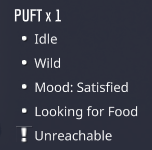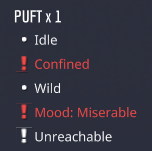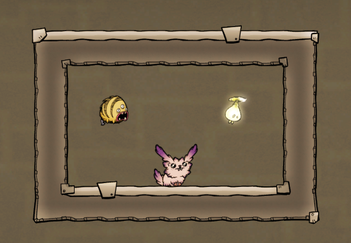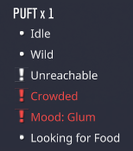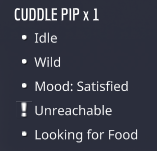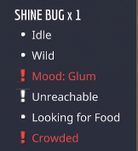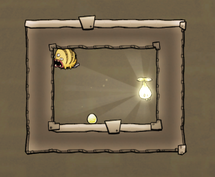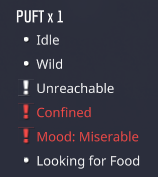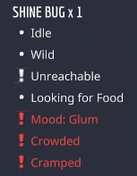Critter
Critters are aliens that lay eggs and some species produce materials and/or drop meat when dying. Ranching can be used to increase the number of critters, eggs, and materials. Some critters have different morphs which consume different foods, live at different temperatures, or produce different products.
List of Critters
| Image | Name | Diet | Produces | Egg | Drops | Stable Limit (96 tiles) |
Note |
|---|---|---|---|---|---|---|---|
 |
Hatch | Food, Raw Mineral, Organic, Metal Ore | Coal, Refined Metal |
 |
Meat | 8 | Will burrow in soft ground during the day, but will stay active if it can't find a place to burrow. |
 |
Shine Bug | Food, Phosphorite |
Light, Decor, Radiation |
 |
None | 8 | Floating/hovering critter, provides a constant source of light and +30 decor in its immediate vicinity. Nice to have in one's base due to the light and decor bonuses. Small health pool and only a small number spawn. |

|
Pip | Arbor Trees, Thimble Reed | Dirt | 
|
Meat | 8 (Pip)
24 (Cuddle Pip) |
Plants loose seeds into soft blocks and can knock items out of storage bins. Cuddle pips hug eggs and dupes, speeding up incubation. |
 |
Drecko | Balm Lily,Pincha Pepper,Mealwood | Phosphorite, Reed Fiber, Plastic |
 |
Meat | 8 | This creature can be found crawling around in cavities in the Caustic Biome. They are able to cling strongly to any surface, and will freely wander the full perimeter of whatever chamber they are in. They are not hostile and are quite mobile, inevitably wandering away from any chamber they are not trapped in. |
 |
Pokeshell | Rot Piles, Polluted Dirt, Slime |
Sand, Pokeshell Molt, Oakshell Molt |
 |
Pokeshell Molt, Oakshell Molt, Raw Shellfish | 8 | Pokeshells will become agressive towards duplicants and other critters if in the vicinity of at least one pokeshell egg. |
 |
Puft | Polluted Oxygen/ Oxygen/Chlorine | Slime/ Oxylite/ Bleach Stone |  |
Meat | 6 | Floating/hovering critter. Its movement is based on invert pyramid shape, moves center to top, left then right, follows bubbles of contaminated air, prefers going up. Sucks in the closest air bubble, goes up into top of room/chamber on borders of gases then spits out slime. Can follow its own slime consuming again. Won't go under water, but can enter a stream of water from below or from the side (and then die). |
 |
Pacu | Algae/ Plant Seeds | Polluted Dirt |  |
Pacu Fillet | 12 | Swims in water, can only be caught via a Fish Trap. |
 |
Slickster | Carbon Dioxide/Oxygen | Crude Oil/Petroleum |  |
Meat | 8 | Floats over the floor or liquid, and follows spots of carbon dioxide. |

|
Shove Vole | Regolith/ Dirt/ Iron Ore | Solid Tile/Tonic Root | 
|
Meat | ∞ | Burrowing critters that eat the Regolith collected on terrestrial surfaces. |
 |
Gassy Moo | Gas Grass | Natural Gas, Brackene | none | Meat | 6 | Extraterrestrial creatures that feed on gas grass and excretes natural gas. |
 |
Morb | none | Polluted Oxygen | none | Polluted Oxygen | ∞ | Spawns from full Outhouses if it filled long enough but can be found naturally, produces contaminated oxygen unless in high-pressure gas, explodes in a puff of Polluted Oxygen or Chlorine upon death. Cannot be Ranched. |
Critters in 
| Image | Name | Diet | Produces | Egg | Drops | Stable Limit (96 tiles) |
Note |
|---|---|---|---|---|---|---|---|

|
Plug Slug | Metal Ore | Hydrogen | 
|
Meat | 8 | Hangs from the ceiling at night providing power to any exposed wires 2-tiles from the ceiling. The amount of power provided is proportional to the hunger & happiness of the Slug. |
 
|
Divergent | Sulphur & Sucrose | Sucrose & Mud | 
|
Meat | 8 (Sweetle) 6 (Grubgrub) |
Will provide a growth bonus on contact with a plant. Allows Grubfruit Plants to produce full size Fruits instead of Spindly Fruits. |

|
Beeta | Uranium Ore | Enriched Uranium | N/A | Nuclear Waste | N/A | Spawned as Beetinys from a Beeta Hive, fully grown up it harvests Uranium ore, delivering it to the hive. Hives convert 90% of the mass of uranium ore into enriched uranium.
Beetas are inherently hostile to anything that is not them, including other critters. |
Critters in The  Pack
Pack
| Image | Name | Diet | Produces | Egg | Drops | Stable Limit (96 tiles) |
Note |
|---|---|---|---|---|---|---|---|

|
Flox | Pikeapple Bush, Pikeapple | Dirt, Wood | 
|
Meat | 8 | Their antlers can be sheared for Wood. |

|
Bammoth | Plume Squash Plant, Plume Squash | Bammoth Patty, Reed Fiber | 
|
Meat | 6 | Their wooly coat can be sheared for Reed Fiber. |

|
Spigot Seal | Bonbon Tree | Ethanol, Tallow | 
|
Tallow | 8 | Seals must be deceased to obtain Tallow. |
Common traits
Most critters share the following traits:
Survival
- Will die when subjected to temperature extremes (specific range depends on species). Tend to migrate to livable temperature zone accessible to it.
- Can live in any atmosphere including Vacuum, yet will drown in liquids (but will try to escape), with exception of Pacus and Pokeshells.
- Common critters, such as hatches, will drown in
- 1) a liquid tile with at least 35% mass of its default mass (i.e. 350kg or more for a water tile) or,
- 2) any liquid environment that is over 2-tiles deep, i.e. in a 10g water tile with any amount of petroleum on top of it.
- On the other hand, Pacus will be reduced to the flopping state in absence of water(or some other liquids they can live in).
- Common critters, such as hatches, will drown in
Lifecycle, behavior, and drops
- Both wild and tamed critters age, lay eggs, and have a capped life expectancy (with exception of Morbs, those have no life-cycle, and Gassy Moos, which lay no eggs).
- Juvenile critters take 5 cycles to grow into an adult.
- A wild critter does not need a diet. Once tamed they will begin to lose calories and starve if not fed after a number of cycles. A tamed critter with "glum" debuff loses calories slower than a happy tamed critter.
- Tamed critters lay tamed eggs. Babies won't starve and don't require a diet. Once matured, tamed critters need a stable food supply to survive.
- Wild critters usually always stay happy, if they have enough space.
- Critters always spawn mid way of their comfortable temperature range. For example, Shove Vole's comfortable range is between -100 °C-148 °F and 400 °C752 °F, so they spawn at 150 °C302 °F.
- Resource conversion can range twentyfold depending on critter status. Happy and Tamed Critters have 100% production, Wild has 25%, Glum has 20%. Wild and Glum has only 5% production rate. See also: Metabolism
- Can arrive as a care package by Printing Pod (except Morbs and Gassy Moos).
- They drop meat or whatever material when they die, no matter of how this happens (being killed by a duplicant, dying of old age, drowning, ...). Killing a Juvenile critter will grant the same amount of output.
- Are not aggressive (with exception of Pokeshell, which will attack anything if there are any of their eggs nearby).
Movement
Most critters:
- Occupy one tile and can crawl into narrow spaces (except Bammoths and adult Pokeshells).
- Can't use ladders for pathfinding purposes
- Can get confined when a tile is built on top of them or were idle in a closing door.
- With Pneumatic Doors, Manual Airlocks and Mechanized Airlocks, critters:
- Can walk through doors & airlocks set to open but will not path through doors & airlocks on locked or on auto
- Can walk on doors & airlocks, whether open, closed, or auto
- If standing on a door or airlock that is opened, the critter will continue standing on it
- If the critter is falling, then:
- It will continue to fall through any door, whether open, closed, or auto
- It will land on closed or auto airlocks, but will fall through open airlocks
- If a critter is standing inside an open door or airlock that is then closed, it will enter a falling state.
- If there are any doors or open airlocks below the critter when the door closes on it, it will fall down.
- If there is a solid tile below the critter, it will remain trapped in the closed door.
Hatch and Morb, as walking critters, share the traits:
- Can walk, jump across 1 tile gaps, climb diagonally 1 tile, and jump up diagonally 1 tile to left/right and 2 tiles up/down.
- Babies can't jump tile gaps, or up/down.
- Non-aquatic critters sometimes jump into a puddle of liquids that's less than 1 tile thick.
Critter Moods
The happiness of a Critter affects their critter metabolism as well as their reproduction rates. A critter can either be Miserable (-10 or less), Glum (-9 to -1), Satisfied (0 to 3), or Happy (4 or more). Miserable critters have 20% metabolism, but 0% reproduction rate. Glum critters have 20% metabolism and 100% reproduction rate. Satisfied critters have 100% metabolism and 100% reproduction rate. Happy critters have 100% metabolism and 1000% reproduction rate.
| Happiness | Metabolism | Reproduction Rate |
|---|---|---|
| -10 | 20% | 0% |
| -9 | 20% | 100% |
| -8 | 20% | 100% |
| -7 | 20% | 100% |
| -6 | 20% | 100% |
| -5 | 20% | 100% |
| -4 | 20% | 100% |
| -3 | 20% | 100% |
| -2 | 20% | 100% |
| -1 | 20% | 100% |
| 0 | 100% | 100% |
| 1 | 100% | 100% |
| 2 | 100% | 100% |
| 3 | 100% | 100% |
| 4 | 100% | 1000% |
- Tamed critters have a base happiness of -1
- Crowding reduces happiness for each critter over the room carrying capacity
- Grooming and Critter Fountain increases happiness by 5
- Critter Condo and Water Fort increases happiness by 1
- Confined reduces happiness by 10
- Starvation reduces happiness by 10
- Body temperature outside of the comfort range reduces happiness by 1
Space Requirements
(See Also, Stable)
| Critter | 
|

|

|

|

|

|

|

|

|

|

|

| ||||
|---|---|---|---|---|---|---|---|---|---|---|---|---|---|---|---|---|
| Required Space | 12 | 16 | 12 | 12 | 12 | 12 | 4 | 12 | 8 | 16 | 12 | 12 | 16 | 12 | 16 | 12 |
| Max Critters in
96 Tile Stable |
8 | 6 | 8 | 8 | 8 | 8 | 24 | 8 | N/A | 6 | 8 | 8 | 6 | 8 | 6 | 8 |
- Pufts, Gassy Moos, and Grubgrubs (Spaced Out) all have the highest Minimum Space Requirement (16 tiles), so fewer can fit in one room at a time.
- Cuddle Pips have the smallest Minimum Space Requirement (4 tiles, four times less than a Puft), so many can comfortably live in the same room.
Confined
"This critter is trapped within a door, tile, or confined space" "Sounds uncomfortable!"
The Critter is in a Room that is too small to meet the Space Requirements of that type of Critter (shown above). This debuff reduces Happiness by 10 and reduces Reproduction Rate by 100%, regardless of any other Reproduction Rate increases.
- This debuff overrides the Crowded and Cramped debuffs, and is seen as the most severe of the three.
- Left: a room with 16 tiles (4x4) that is comfortable for a single Puft.
- Right: a room with 12 tiles (3x4) that is not comfortable for any Pufts.
Crowded
"This critter isn't comfortable with so many other critters in a Room of this size."
The Critter is in a Room where the sum of all space requirements based on the amount of Critters inside exceeds the room size. The effect reduces a critter's happiness by 1 for each critter over the room's carrying capacity.
- It will calculate Crowding by counting the total amount of Critters in the same room (itself included), and multiplying that number by it's personal Tile Space Requirement to compare to the room size (See Examples).
- If the final number exceeds the current room size, that Critter will feel Crowded.
- In this first example (above) both rooms have a space of 28 tiles (4x7).
- The Cuddle Pips is not Crowded, as the total of 3 Critters multiplied by it's Space Requirement of 4 equals 12, much less than 28.
- The Shine Bug is Crowded, and while only one other Critter wouldn't crowd it, having three total exceeds the room's space. (3x12=36>28)
- The Puft is Crowded, as only one Puft would be comfortable in a 28 tile room, and more would overcrowd it (2x16=32>28).
- Since the Shine Bug would be comfortable with one less Critter in the room, it only gets a -1 Happiness debuff
- Because the Puft is not comfortable with having any additional Critters, it gets a -2 Happiness debuff (-1 for both critters)
Cramped
"This Room will become too crowded once all nearby Eggs hatch" "The selected Critter has slowed it's Reproduction to prevent further overpopulation."
The Critter is in a room where the amount of Critters inside including the Critter Eggs in the room, multiplied by the Critter's Space Requirement is greater than the current size of the Room. The effect reduces Critters reproduction rate to 0% preventing further overpopulation.
- While very similar in calculation to Crowded, but this de-buff only decreases Reproduction Rate, yet can still affect Critters that are Crowded
- It als includes Critter Eggs to the total Critter count instead of just the amount of Critter in the Room.
- As stated above, Confined overrides the Cramped status, as it already affects Happiness and Reproductive Rate.
- The room in the picture is 12 tiles large (3x4), and does not meet the minimum room requirements of the Puft, making it Confined.
- Note that Shine Bugs are usually comfortable in 12 tile rooms, but the addition of a Puft causes Crowding, and the Egg causes Cramping.
Exceptions
- Morbs are ignored when calculating the required room size.
- Shove Voles will count towards the stable overcrowding, however, they do not care about any amount of overcrowding themselves.
- Cuddle Pips consider each egg type to only require 4 tiles of space








